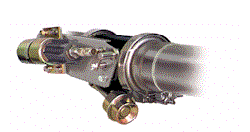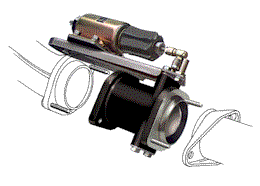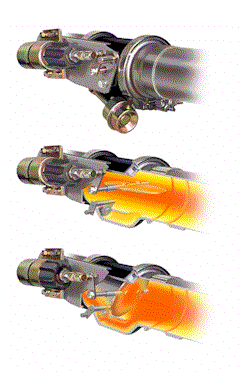
D-Celerator®
Diesel Exhaust Brake
Take the Terror Out of Downhill Towing
Add Thousands of Miles to Your
Vehicle's Brakes
Extend Engine Life With Rapid Cold
Weather Warm-Up
Patented Waste-Gate Design Gives
Powerful Braking at Lower RPMs

Does this sound familiar?
A driver towing a heavy load or driving a big
motorhome has finally made it – he has crested the top of that mountain grade
and it’s all downhill from here. He peers down the highway in front of him
running down the side of the mountain and realizes he has a new set of
challenges.
He has a four mile, seven percent grade to navigate with tons of metal riding behind him and all he has are a set of overworked vehicle brakes to slow his growing momentum as he starts to gain downhill speed without so much as a tap on the throttle.
He looks to his right over the edge of the guardrail and can’t see the bottom! Returning his gaze to the road in front of him he sees, becoming clearer every moment, a line of vehicles at a stop sign at the bottom of the hill. And all of a sudden there are butterflies coming to life in his stomach and they are beating their wings furiously.
The driver realizes he is in a "free fall" with no speed retarding assistance from his engine, so he begins to pump the brake pedal. While he feels some temporary assistance, and a little security from knowing he is no longer rocketing down the side of a mountain, he notices that the blood is leaving his knuckles as he grips the steering wheel. He downshifts and his RPMs begin to soar, but his speed continues to increase. So as the skin covering the back of his hands becomes almost transparent, he decides to take the next step – the final option.
He stands on the brake pedal with such force that he lifts himself out of the driver’s seat far enough to slip a two by four between him and the upholstery. Finally, his momentum begins to slow – a little. Now his sense of smell kicks in and as he sniffs the air, he smells something. What is that? Can a person smell heat? It sure seems like something is burning and he recognizes the pungent odor of overheating brakes.
As his brakes begin to roast, they also begin to fade and lose braking effectiveness. The driver realizes that he is driving on a wing and a prayer, and he hopes for the best as his lively descent down the mountain grade continues unabated.
Why do these problems occur?
A new diesel owner, especially one who is unfamiliar
with the difference between how a diesel engine works compared to the gasoline
engine he is used to, may be unprepared for the braking challenges presented by
his new fuel-efficient, cost-saving diesel.
At its very center, the problem arises from the way the engine runs when there is no pressure on the throttle. When a gasoline engine is idling, the throttle body butterfly rests in a closed state. The butterfly cuts off air flow so the engine generates vacuum as the pistons are continually trying to draw air into the cylinders. This vacuum has a retarding effect on engine output and automatically provides some braking assistance on downhill grades when the driver’s foot is not on the throttle.
This butterfly-generated vacuum assistance does not exist in a diesel engine. Even when there is no throttle pressure, the diesel continues to pump air into the engine.
Is there a solution to fix this problem?
Yes! For decades, big rig drivers have used engine
brakes and exhaust brakes to restrain the engines in their heavyweight diesel
tractors. Since engine brakes create so much noise, they have been outlawed in
several mountain communities, and even at entrances to toll booths on
level-terrain highways. The use of engine brakes has been severely curtailed. So
even though they are effective, they are annoying – and often illegal!
On the other hand, exhaust brakes are relatively quiet. They build the back pressure required to retard the vehicle’s momentum without producing all the clatter.
In the early 1990s this "big rig" technology became available to pickup and motorhome owners.
How does an exhaust brake do what it does?
In effect, an exhaust brakes turns the diesel engine
into a big compressor. In contrast to the gasoline engine which restricts air
intake, the exhaust brake restricts exhaust outflow to create pressure. And with
diesel engines creating 200+ horsepower, regulating back pressure can provide
powerful braking assistance for the diesel owner.
On most downhill grades exhaust brakes engage automatically to help slow the vehicle’s momentum. This permits the diesel-powered pickup or motorhome to stop quicker. Exhaust brakes also save wear and tear on the wheel brakes. Finally, and most importantly, safety is increased and the butterflies in the driver’s stomach go back to sleep and the driver is truly in control of his rig.
U.S. Gear offers exhaust brake alternatives
U.S. Gear offers two types of exhaust brakes – both utilize butterfly valves to create back pressure.
The "Standard" Model
Like all other exhaust brakes, the
"Standard" model D-Celerator controls pressure using orifices (holes)
in the butterfly. The orifice is sized at the factory to keep your engine from
over-pressuring at extreme RPMs.
If you drive a small pickup or motorhome, and you rarely visit mountain communities, then the "Standard" is the perfect solution to help your vehicle perform up to its braking potential.
The "Super Duty" D-Celerator
The waste-gate valve spring is pre-set at the factory to open only as often and as much as necessary to avoid damage to your specific diesel engine.
Better performance at lower RPMs
The unique design of the "Super Duty" D-Celerator
allows it to build pressure very quickly at lower RPMs. because of the
waste-gate you can receive the benefit of maximum back pressure almost all the
time without excess pressure. And what is the benefit? – additional braking
assistance you can feel in the seat of your pants almost immediately after the
exhaust brake is engaged.
Since most diesel owners ideally run at 1,500 – 2,000 RPMs, the "Super Duty" model is the clear winner in working with the engine to provide maximum braking performance.
So if you sometimes tow heavy loads, or drive a large motorhome, or often drive in hilly or mountainous areas, then the "Super Duty" D-Celerator is for you. Even if those situations don’t describe your driving patterns, you may decide to use the "Super Duty" model simply to save wear and tear on your vehicle brakes.
No matter what your situation, we have an exhaust brake to meet your needs! Why U.S. Gear?The D-Celerator advantage includes the fact that both models are the only computer-controlled exhaust brakes in the industry. This gives U.S. Gear the freedom to add extra innovations such as the outstanding "cycle feature." The cycle feature eliminates a problem common to the exhaust brake industry. Specifically, the cycle feature does away with the soot build-up from diesel exhaust which causes the butterfly to bind, generally from lack of use.
In addition to their "self-maintenance" characteristics, stainless steel components also extend the durability of the U.S. Gear diesel exhaust brakes.
Because all D-Celerators are installed downstream in the exhaust system where there is more space, U.S. Gear’s exhaust brakes have an oversized casting. This means that since the exhaust brake is not in use 95% of the time, the open butterfly and pivot shaft don’t present a barrier to the swirl of diesel exhaust gases exiting the turbo. In fact, the D-Celerators actually improve flow by increasing the area available in the exhaust stream.
D-Celerators are available in a wide variety of models ranging from 2.5" to 4" and either air-activated or electric-activated. U.S. Gear’s exhaust brakes are easy to install and are proudly made in the USA.
To top it all off, the D-Celerators are accompanied by the best warranty in the industry and both models have a 90 day customer satisfaction guarantee.
Why look anywhere else?
U.S. Gear has more than 40 years of manufacturing
experience and is a recognized leader in the diesel and RV performance industry.
The family owned and managed company uses the most current of today’s
technology to build products with old-fashioned values – like pride in
workmanship and meeting the real needs of customers. U.S. Gear is not really a
corporation as much as it is a group of people just like you – people who work
hard and expect extraordinary value in the products they use. We would never
consider producing anything less than the very best.
Remember that regardless of your driving patterns, there is a D-Celerator that is right for your diesel pickup or motorhome.
Application